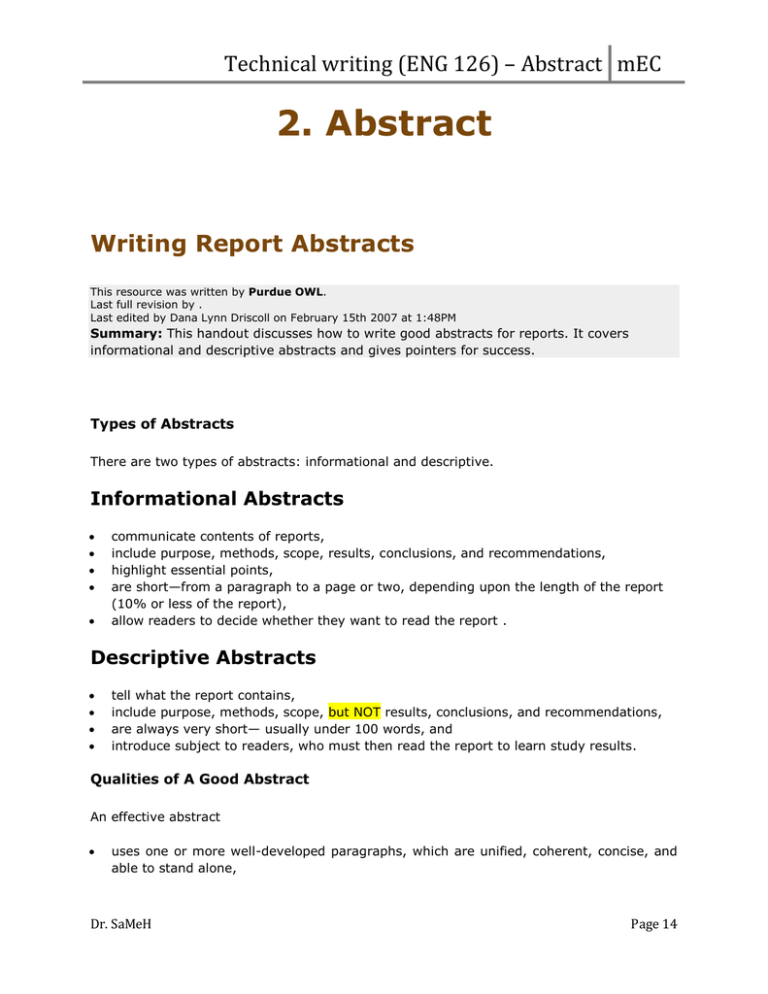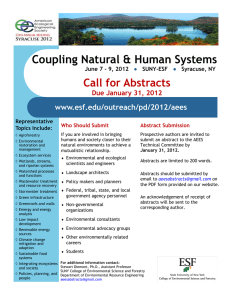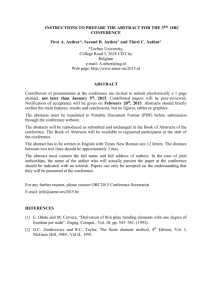ENG-126-ABSTRACT
advertisement

Technical writing (ENG 126) – Abstract mEC 2. Abstract Writing Report Abstracts This resource was written by Purdue OWL. Last full revision by . Last edited by Dana Lynn Driscoll on February 15th 2007 at 1:48PM Summary: This handout discusses how to write good abstracts for reports. It covers informational and descriptive abstracts and gives pointers for success. Types of Abstracts There are two types of abstracts: informational and descriptive. Informational Abstracts communicate contents of reports, include purpose, methods, scope, results, conclusions, and recommendations, highlight essential points, are short—from a paragraph to a page or two, depending upon the length of the report (10% or less of the report), allow readers to decide whether they want to read the report . Descriptive Abstracts tell what the report contains, include purpose, methods, scope, but NOT results, conclusions, and recommendations, are always very short— usually under 100 words, and introduce subject to readers, who must then read the report to learn study results. Qualities of A Good Abstract An effective abstract uses one or more well-developed paragraphs, which are unified, coherent, concise, and able to stand alone, Dr. SaMeH Page 14 Technical writing (ENG 126) – Abstract mEC uses an introduction-body-conclusion structure in which the parts of the report are discussed in order: purpose, findings, conclusions, recommendations, follows strictly the chronology of the report, provides logical connections between material included, adds no new information but simply summarizes the report, and is intelligible to a wide audience. Steps for Writing Effective Report Abstracts To write an effective report abstract, follow these four steps: 1. Reread your report with the purpose of abstracting in mind. Look specifically for these main parts: purpose, methods, scope, results, conclusions, and recommendations. 2. After you have finished rereading your report, write a rough draft WITHOUT LOOKING BACK AT YOUR REPORT. Consider the main parts of the abstract listed in step #1. Do not merely copy key sentences from your report. You will put in too much or too little information. Do not summarize information in a new way. 3. Revise your rough draft to o correct weaknesses in organization and coherence, o drop superfluous information, o add important information originally left out, o eliminate wordiness, and o correct errors in grammar and mechanics. 4. Carefully proofread your final copy. Dr. SaMeH Page 15 Technical writing (ENG 126) – Abstract mEC How to Write an Abstract An abstract condenses a longer piece of writing while highlighting its major points, concisely describing the content and scope of the writing, and reviewing the content in (very) abbreviated form. A research abstract concisely states the major elements of a research project. It states: purpose, methods, and findings of the research. Writing a good abstract requires that you explain what you did and found in simple, direct language so readers can then decide whether to read the longer piece of writing for details. WhiteSmoke software can use its writing enrichment features to check your vocabulary and suggest more precise words. Its online dictionary and thesaurus software will further help you refine the language so that each word says exactly what you need it to say. The audience for an abstract should be broad--from expert to lay person. Find a comfortable balance between writing an abstract that both provides technical information and remains comprehensible to non-experts. Keep technical language to a minimum. Don't assume that the audience has the same level of knowledge as you. Use WhiteSmoke's dictionary to make sure that the terms you use are clear and correct. Here's how to write an abstract: Whatever kind of research you are doing, after you write about it you usually write a short abstract that provides the reader with the answers to the following questions: 1. 2. 3. 4. 5. 6. What are you researching (what's the question you're asking)? Why is it significant, important, of interest? How will you study it, that is, what methods will you use? How will you demonstrate your conclusions? That is, what evidence have you found? What are your conclusions? What do they mean? An experimental research abstract, sometimes called a scientific abstract, (100 words or fewer) usually includes, in this order: 1. 2. 3. 4. The title of the paper. A brief discussion of context or background. The study's objectives--what is the question under discussion? A brief summary of major results and their significance. Dr. SaMeH Page 16 Technical writing (ENG 126) – Abstract mEC 5. 6. Main conclusions (or hypothesized conclusions). One sentence discussing the relevance or future directions for research. Abstracts for text-based research projects, or research paper abstracts, (no more than 250 words) usually include: 1. 2. 3. 4. 5. Paper title. A brief discussion of context or background. The study's objectives--what is the question under discussion? The key subtopics explored? what argument are you proposing about the topic? A brief reference to the nature of the source material and methodology (if relevant) library research? analysis of fictional texts? interviews or observations? 6. Main conclusions (or hypothesized conclusions). 7. The implications or significance of the findings. Use WhiteSmoke while writing an abstract. Its English grammar checker will catch any mistakes right away. Its contextual spell checking catches errors other softwares miss. WhiteSmoke writing software makes writing an abstract easier than ever. An abstract is usually short, only one paragraph. It should never exceed the word limit provided by the journal or recommended research style manual (for instance, APA style or MLA style). Make sure it is: 1. 2. 3. 4. Complete - covering all the major parts of the project. Cohesive - flowing smoothly throughout. Concise - containing no extra words or unnecessary information. Clear - remaining readable to both experts and non-experts, even in its condensed form. How to write an abstract: 1.) Make notes about the logistics and rhetorical situation- Deadline (when is it due?) Length (APA style-100 words; MLA style-250 words, both maximum--check the guidelines for where the abstract will be submitted) Purpose (to communicate clearly to your various audiences what you have researched, to be accepted at a conference, to have an article accepted by a journal, etc.), and Audience (Who are your intended expert and non-expert and what information will they expect and want to know?). Dr. SaMeH Page 17 Technical writing (ENG 126) – Abstract mEC 2.) Write a draft that follows the guidelines from number 1, above. Get feedback on the draft from colleagues, supervisors, teachers, etc.--someone who has not read the longer work. See what questions they have and ask them to explain to you what they expect from the longer work. This will help you to see if the abstract is doing its job. Use the English grammar checker while writing the draft and the writing enhancement feature that serves as a vocabulary check. 3.) Revise the abstract based on the feedback. Plan to revise often to get it right and to keep it within the word limit. Be sure to use the WhiteSmoke spell check and grammar check while revising. Also, this is a good time to use the powerful thesaurus to suggest more effective language and the large dictionary to make sure that you are using each word correctly. 4.) Be sure your abstract is grammatically correct with correct spelling and punctuation by using WhiteSmoke English grammar check and spell check one more time! Dr. SaMeH Page 18



